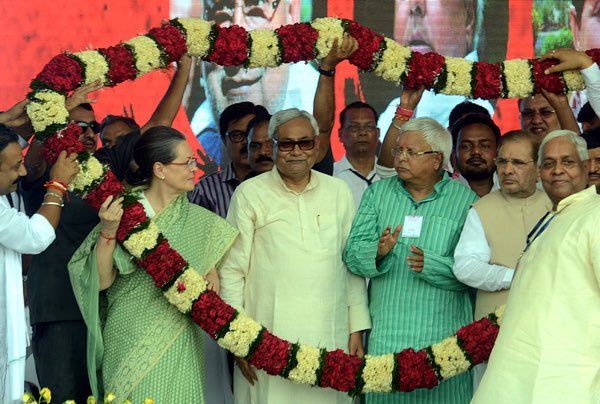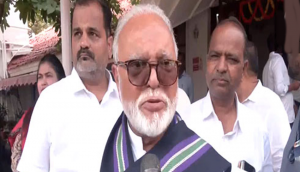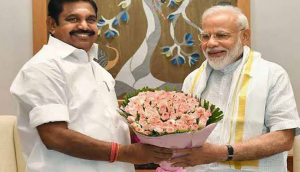Bihar in numbers: all you need to know about 2015's biggest political battle

The Election Commission announced the schedule for the Bihar Assembly elections on Wednesday. The elections will be held in five phases spread across four weeks between 12 October and 5 November.
Ever since Narendra Modi became the Prime Minister, the BJP has had an unbeaten run across the country, with the exception of Delhi where it got swept away by an AAP wave.
Unlike states like Haryana, Maharashtra and Jharkhand, where the BJP won without a significant challenge, it is facing a tougher fight in Bihar with the Janata Dal (United), Rashtriya Janata Dal and Congress coming together to put up a united 'secular' fight.
These numbers reflect why the Battle for Bihar is bigger than any of the Assembly elections that have taken place since last year.
The big picture:
The total number of people who are eligible to vote in the 2015 Bihar Assembly elections
The increase in the number of voters from the 2010 elections in which 4.62 crore voters were on the rolls.
The number of constituencies up for grabs in these elections. 38 of these are reserved for Scheduled Castes and 2 for Scheduled Tribes
The number of seats that are considered affected by Left-wing extremism
The number of polling stations in Bihar
The number of voters below the age of 30
Caste calculus:
Even though both the alliances are devoting immense time, energy and resources on branding and publicity, the election may still boil down to caste.
Many analysts have stressed the importance of the Mahadalit factor and how the "emergence" of Jitan Ram Manjhi as the face of the community will benefit the NDA. Perhaps the Mahadalit factor and Manjhi's popularity are being overestimated. The real X factor in the elections is how the Extremely Backward Communities will vote.

Photo: Santosh Kumar/Hindustan Times via Getty Images
The share of Extremely Backward Castes in the state's population. This includes communities like Vishwakarma, Teli, Mallah, Tanti, Badhai, Maali. None of the parties have a prominent face from this section. EBCs hold the key in this election.
The sub-quota given by Nitish Kumar to EBCs within the 27% OBC quota.
The percentage of Mahadalits in Bihar's population. Other Dalits account for about 6%.
The share of Muslims in Bihar's population. Combined with the 14% Yadav vote, this has been critical to the RJD's success.
The Upper Caste vote in Bihar, of which the BJP is likely to garner an overwhelming majority.
Lalu and Nitish can still pull it off:
The NDA swept Bihar in the Lok Sabha elections, winning 31 out of 40 seats.
The number of assembly segments the BJP and its allies led in during the 2015 Lok Sabha elections. This is an over 2/3rd majority for the NDA.
The number of segments in which the UPA (RJD, Congress and NCP) were ahead. JD(U) and the Left Parties led in just 19 seats.
But Nitish and Lalu could potentially turn the tables by coming together. The combined vote share of the JD(U)-RJD-Congress alliance exceeds the NDA by a significant margin.
The NDA's vote share in the 2014 Lok Sabha elections in Bihar.
The combined vote share of the JD(U), RJD and Congress in the Lok Sabha elections. This is 5.5% higher than the NDA's vote share.
Now, how does this translate in terms of Assembly seats?
The number of Assembly segments which the JD(U)-RJD-Congress alliance would have led on had they contested together.
The number of Assembly seats in which the NDA would still be ahead of the Grand Alliance.
Samajwadi Party: nothing more than nuisance value:
The Samajwadi Party's exit is said to have weakened the Grand Alliance. This may be true in terms of perception as it gives BJP the chance to present it as an unviabe alliance. But in terms of numbers, the SP's exit is unlikely to harm Nitish Kumar.
The number of seats SP contested in 2010.
Total number of votes garnered by the SP in Bihar.
SP's vote percentage in the seats it contested. Given the paltry vote share of the SP in the state, the party can harm the Grand Alliance in extremely tight battles or by giving tickets to JD(U), RJD or Congress rebels.
First published: 10 September 2015, 1:32 IST






![BJP's Kapil Mishra recreates Shankar Mahadevan’s ‘Breathless’ song to highlight Delhi pollution [WATCH] BJP's Kapil Mishra recreates Shankar Mahadevan’s ‘Breathless’ song to highlight Delhi pollution [WATCH]](https://images.catchnews.com/upload/2022/11/03/kapil-mishra_240884_300x172.png)

![Anupam Kher shares pictures of his toned body on 67th birthday [MUST SEE] Anupam Kher shares pictures of his toned body on 67th birthday [MUST SEE]](https://images.catchnews.com/upload/2022/03/07/Anupam_kher_231145_300x172.jpg)






